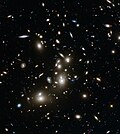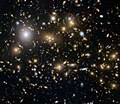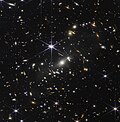Top Qs
Timeline
Chat
Perspective
List of deep fields
From Wikipedia, the free encyclopedia
Remove ads
In astronomy, a deep field is an image of a portion of the sky taken with a very long exposure time, in order to detect and study faint objects. The depth of the field refers to the apparent magnitude or the flux of the faintest objects that can be detected in the image.[2] Deep field observations usually cover a small angular area on the sky, because of the large amounts of telescope time required to reach faint flux limits. Deep fields are used primarily to study galaxy evolution and the cosmic evolution of active galactic nuclei, and to detect faint objects at high redshift. Numerous ground-based and space-based observatories have taken deep-field observations at wavelengths spanning radio to X-rays.
Comparison of how far in the past some of the Hubble Space Telescope's deep fields have seen in terms of redshift and million years and also how far the James Webb Space Telescope should be able to see.
The first deep-field image to receive a great deal of public attention was the Hubble Deep Field, observed in 1995 with the WFPC2 camera on the Hubble Space Telescope. Other space telescopes that have obtained deep-field observations include the Chandra X-ray Observatory, the XMM-Newton Observatory, the Spitzer Space Telescope, and the James Webb Space Telescope.
Remove ads
Table
Summarize
Perspective
The following table gives a partial list of deep-field observations taken since 1995.
Remove ads
See also
Wikimedia Commons has media related to Deep fields.
References
Wikiwand - on
Seamless Wikipedia browsing. On steroids.
Remove ads




























